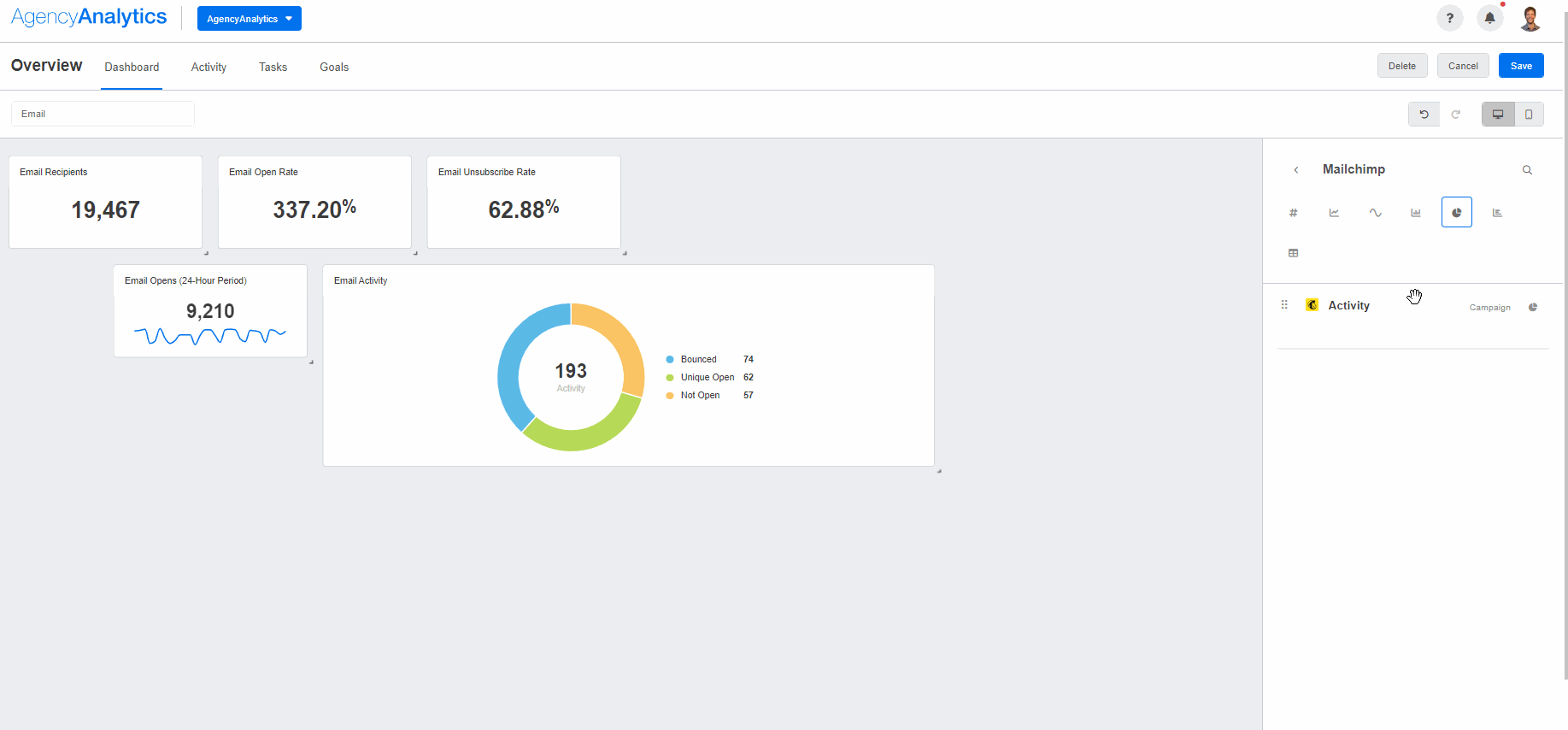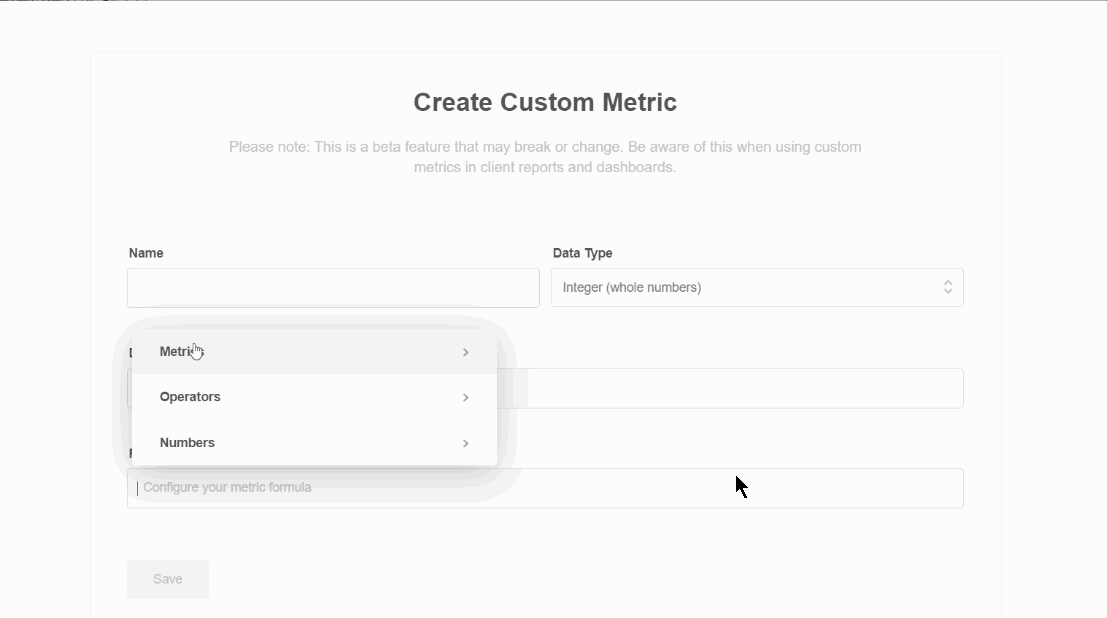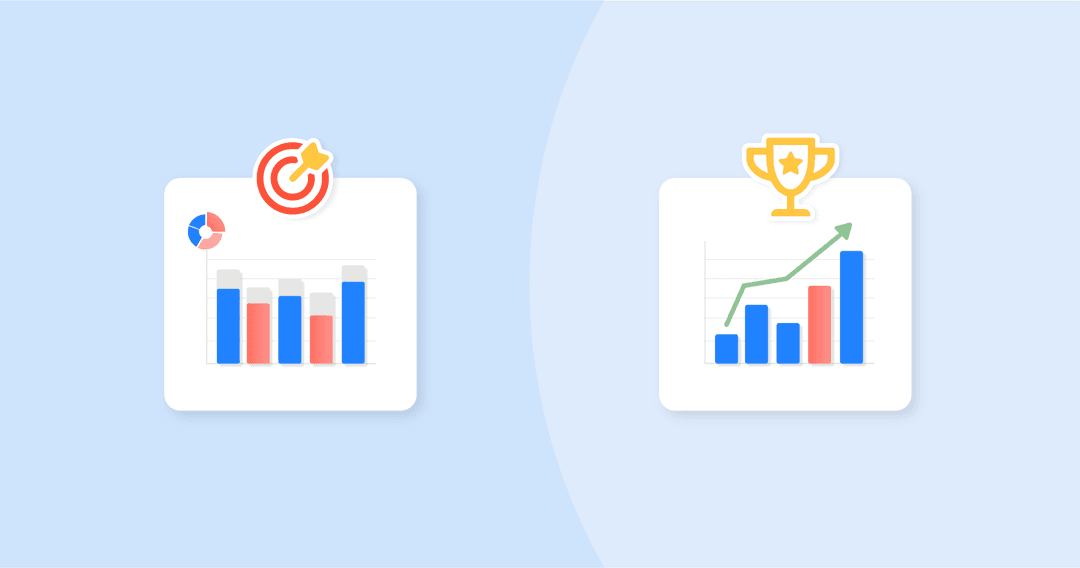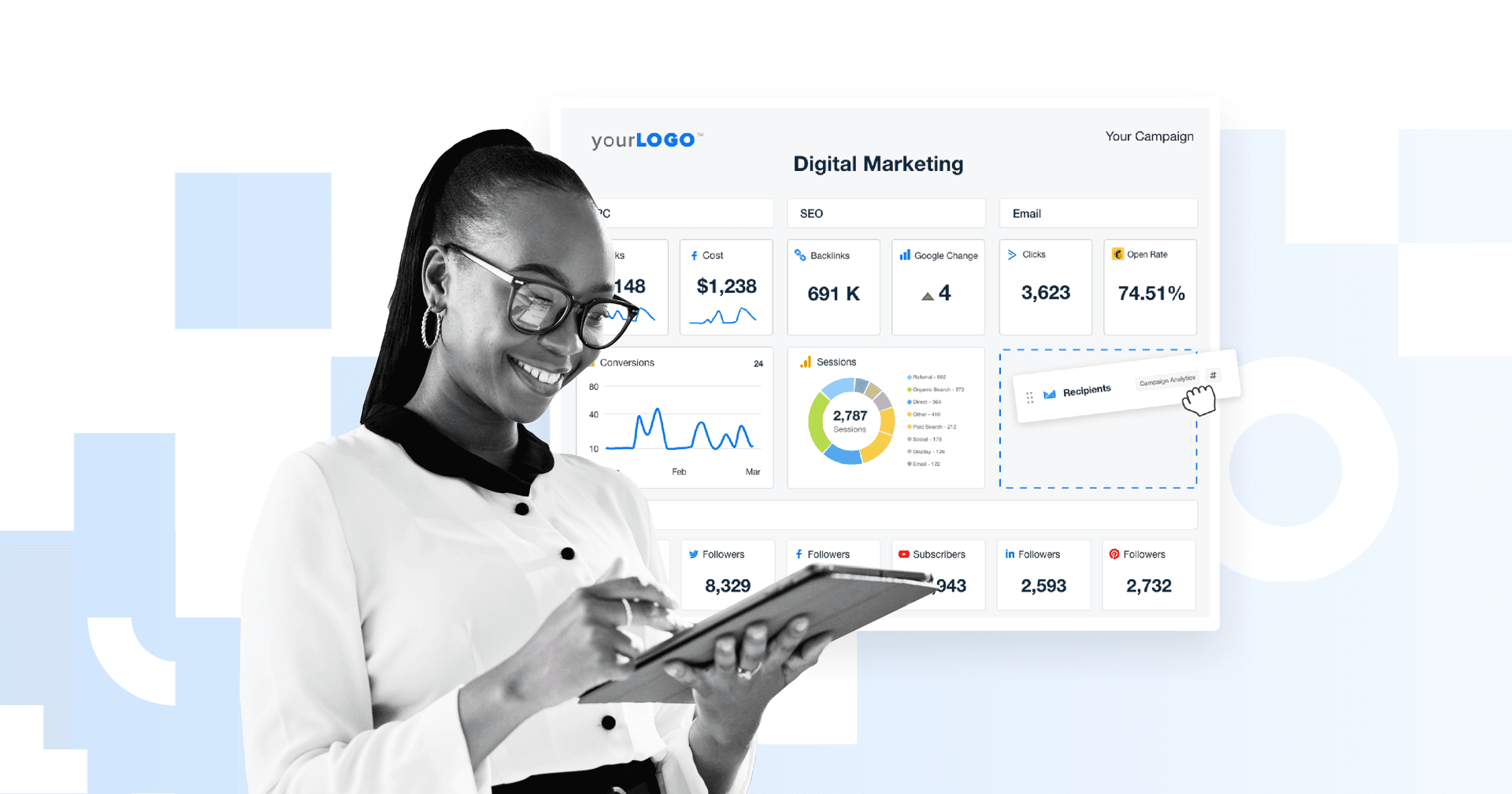Table of Contents
Table of Contents
- Why KPIs and OKRs are Important
- What Is a Key Performance Indicator (KPI)?
- What Are Objectives and Key Results (OKR)?
- OKRs vs. KPIs: What Are the Similarities and Differences?
- When To Use OKRs Instead of KPIs
- The Interplay Between OKRs and KPIs
- What Are Common Mistakes to Avoid With KPIs and OKRs?
- Should You Implement OKRs in Your Own Agency?
- Summary: OKRs vs KPIs, Similar But Different
7,000+ agencies have ditched manual reports. You can too.
Free 14-Day TrialQUICK SUMMARY:
OKR stands for Objectives and Key Results, while KPI refers to Key Performance Indicators. OKRs set ambitious goals with measurable outcomes, and KPIs are the metrics tied to specific business objectives. This article explores the difference between an OKR and a KPI, highlighting how they complement each other in strategic planning and performance measurement.
Welcome to the world of OKRs vs KPIs, which are more than acronyms, they are the compass guiding us through a complex digital landscape. For the uninitiated, OKRS stands for Objectives and Key Results, and KPIs stands for Key Performance Indicators, respectively. Let's not just stop at decoding the acronyms, though.
Within client reporting and account management, OKRs and KPIs represent the two essential pillars. They are individual yet intertwined, and understanding the unique roles and interplay of OKRs vs KPIs is crucial. Think of them as the rhythm and melody in a song, each holding their ground, yet creating harmony when they come together.
This guide is designed to equip your agency's marketing team with a deep understanding of KPIs and OKRs and how they drive business growth. We're not just about throwing out fancy words and leaving you in the dust. Instead, we aim to make sense of these terminologies and how they can be effectively applied in the practical world.
The focus here is on how these objectives and indicators, OKRs and KPIs, work in tandem, creating a more informed and strategic approach to account management.
Why KPIs and OKRs are Important
Tracking marketing metrics is non-negotiable when it comes to running an agency. While key performance indicators (KPIs) are already an integral part of your operations, there’s another system to track performance: objectives and key results (OKRs).
Your clients probably don’t care about the difference between KPIs and OKRs–they just want results. It’s your job as an agency to sit with them to understand their business goals, set up the right metrics to track your progress, and then let them know how you’re getting them there.
Let’s dive in.
What Is a Key Performance Indicator (KPI)?
Key performance indicators (KPIs) are metrics that directly tie into your client’s business goals.
Note the difference between KPIs vs metrics. Your agency may track many metrics–but that doesn’t mean they all equally contribute to your clients’ long-term goals. And while all KPIs are metrics, not all metrics are key performance indicators (KPIs).

Some of your clients may not know about KPIs but set this foundation early on to establish reporting best practices. Explain to them that KPIs tie directly into their business goals, and emphasize the importance of tracking them. After all, it’s the only way to progress and improve.
Monitoring KPIs has two-fold benefits: Not only will your clients understand what’s happening in their business, but you’ll also demonstrate your agency’s ROI and ability to achieve results.
Agency Tip: For easier comprehension, incorporate data storytelling and data visualization as part of your clients’ KPI reports.
KPI Examples
Common KPI reporting examples to track clients’ marketing performance include:
Weekly website visits
Organic search rankings
Daily sales qualified leads
Email clickthrough rate per campaign
These will vary based on your client's goals, so be sure to choose the most relevant KPIs if your agency decides on this option.
What Are Objectives and Key Results (OKR)?
The OKR system was most recently popularized by Google and is used as a means for teams and organizations to define measurable goals.
This goal-management system breaks down a goal into two components:
Objectives (the O part of OKRs) – The goal you want to achieve.
Key Results (the K & R parts of OKRs) – The measurable results you need to achieve that goal.
The OKR framework involves setting an ambitious goal that may or may not be achieved. Although this might sound counterintuitive to the ingrained concept of SMART goals, there's a reason for that.
It’s an intentional tactic to set high, aspirational targets and take business goals up a notch. OKRs also encompass something similar to KPIs (known as ‘Key Results’ in this framework), which are used as data measures of success toward the specified objective.
Think of this long the lines of that classic quote by Normal Vincent Peale.
“Shoot for the moon. Even if you miss, you'll land among the stars.”
The reason behind setting aggressive–and sometimes unrealistic–goals is that even if you don't achieve them, your client will be better off than when you started.
The challenge with setting these kinds of "shoot for the moon" goals is that you run the risk of constantly underperforming–which is never a good look for a marketing agency.
That's why it's important, if your client uses the OKR framework, to clarify if the goal is to hit 100% success for every goal. For most who are using OKR vs KPI frameworks, the targets are set high to encourage pushing boundaries. In fact, getting close to 100% completion on all of your OKRs typically means they were not ambitious enough.
Example of an Objective and Key Results (OKR)
Objectives and their associated Key Results are typically set within the same timeframe or deadline to achieve. This is one of the foundational principles of the OKR framework: Key Results serve as the measurable steps toward achieving the Objective within a specific timeframe. So if Objectives are set for the quarter, Key Results are typically also set for the quarter.
Let’s look at an example of an OKR you might set for a client trying to market their SaaS business:
Objective: Scale aggressively by achieving 500 new free trials per month.
Key Result 1: 55,000 organic site visits from target countries by the end of the quarter
Key Result 2: Create a product marketing funnel and automation system to bring in 1,500 new trials by the end of Q3.
Key Result 3: Manage customer reviews and seek out 200 more positive reviews by end of Q3.
In this scenario, the ‘Objective’ is an ambitious goal that surpasses your client’s current business outlook and pushes them to achieve a high-reaching, aggressive target.
Even if this objective isn’t met, your client will still achieve success by getting marginally close to this desired target (provided they’ve followed through on implementing key results).

Visually showcase your client’s marketing funnel with AgencyAnalytics. With over 80 integrations (including HubSpot), the possibilities are endless. Try it free for 14 days.
What Makes An Effective OKR?
An OKR is made up of three components:
Different levels
A clearly defined timeframe
A way to track progress
Let’s explore each component further.
1. Levels
OKRs are usually set at the following three levels:
Company Wide (with OKR examples like total revenue or increased brand awareness)
Team (e.g., the Marketing Team OKR to find the best way to attract MQLs)
Individual (e.g., conversion rate improvements assigned to the CRO manager)
As an agency, your role is to take the COMPANY OKR (this is your client’s business goal) and get your TEAM (your marketing agency) to work together to set INDIVIDUAL goals–aka, goals for specific campaigns and campaign specialists.
2. A Clear Timeframe
At each level, set 3-5 OKRs with either an annual or quarterly timeframe. Using over 5 OKRs will risk diluting your agency’s or client’s focus, which is counterproductive.
If you’re using an annual timeframe, use quarterly OKRs to support it. That way, you’ll know exactly what needs to be done each month.
For example, if the goal is to increase the conversion rate by 20% by the end of the year, you can break that down into smaller conversion rate improvements (e.g., 5%) each quarter.
3. Grading to Measure Progress
There are two distinct ways to measure OKR progress:
Binary: A key result is graded as either ‘0’ (not achieved) or ‘1’ (achieved).
On a spectrum: A key result is graded between 0 and 1 (or on a percentage scale of 0% to 100%). Scores closer to 0 indicate that key results are far off track. On the other hand, scores closer to 1 indicate a higher likelihood of success.
Let’s take an example. Say your client sets a key result as ‘get the brand live on TikTok before the end of the month,’ which is tied to their overall objective of getting 1,000 sales in that quarter. At your next monthly meeting, they’re most interested in answering the question, ‘Was the TikTok campaign launched or not?’
A binary key result works well in this case because it’s either a yes (binary score of 1) or no (binary score of 0). Think about it–there’s no way that 0.5 of a TikTok account could be launched!
The challenge with a binary result is that it doesn't take into account the work in progress toward that result. Your team might be 90% of the way to completing the client's TikTok setup, but if it's not completed by the deadline, it counts as "not achieved."
On the other hand, another client may have a company-wide aim to hit a $100,000 sales target coupled with a key result of ‘increasing website traffic to 10,000/month’.
A spectrum works well to monitor progress as website visits climb before the month’s end. At mid-month, your agency may report a score of 0.60, which tangibly shows you’re on track to deliver their key result by the end of the month.
Setting Ambitious Goals with OKRs
One interesting feature of OKRs is that the objective is supposed to be an ambitious “stretch” goal: your client should set an objective that’s possible without necessarily knowing if it can be achieved.
For example, Google aims for an OKR score of 0.6 - 0.7, which means that employees are expected to fall short despite doing their best. In fact, consistently hitting an OKR score above 0.7 is a cause for concern since it means they’re not being ambitious enough when setting their goals.
It’s important to note that OKRs are not tied to compensation in these use cases because the system is meant to encourage risk-taking and for teams to work together to push boundaries.

Whether you’re using OKRs or KPIs, use the annotations and goals feature on AgencyAnalytics to stay one step ahead. Create your own custom goals with a free 14-day trial.
OKRs vs. KPIs: What Are the Similarities and Differences?
As we’ve outlined, OKRs and KPIs work in tandem with your clients’ business goals. Here’s a quick summary of their similarities and differences.
Similarities | Differences |
|---|---|
Similarities KPIs and OKRs are both data-driven and focused on specific targets | Differences OKRs are ambitious, directional, and contextual; KPIs only provide data points |
Similarities KPIs and OKRs are based on the successful delivery of key results | Differences OKRs (somewhat) encompass KPIs but not vice-versa |
Similarities KPIs and OKRs provide reliable insights that could be used to propel a business forward | Differences OKRs include grading (binary or spectrum) to track success–KPIs only report on pre-determined data measures |
Similarities KPIs and OKRs are time-sensitive and specific | Differences OKRs are set quarterly or annually; KPIs could follow other time intervals (e.g., weekly, monthly) |
While OKRs and KPIs both provide valuable insights, the major difference is that OKRs include an overall target that guides all key results.
As such, OKRs give a ‘why’ and an explanation for your client’s key results, which is helpful for context and understanding the big picture.
KPIs, however, solely provide data progress and don’t always tie into an ambitious goal or objective. Nonetheless, OKRs and KPIs are both valuable measures to drive your client closer to success. However, there are instances when one works better than the other–let’s explore below.
When To Use OKRs Instead of KPIs
As outlined, OKRs encompass something akin to KPIs as part of the overall goal framework. But when is it best to use an OKR framework vs. KPIs? Let’s explore this further with an example.
Say your client aims to reach 1M website views in the 2nd quarter of the year. To get there, you may set actionable KPIs such as injecting $50,000 in Google display ads and churning out 20 blogs per month.
In this case, an OKR framework will work to reach your client’s ambitious target (or at least close to it). While those KPIs work as standalone measures, the OKR framework adds context and purpose.
On the other hand, say your client doesn’t have such aggressive targets and is only interested in maintaining a baseline, manageable level of web visibility. KPIs alone may do the trick without the need for a high-reaching objective.
In a nutshell, an OKR framework may work better for businesses with an ambitious vision. However, KPIs may be standalone metrics that reflect and maintain business health.

Whether you’re setting an ambitious OKR target or monitoring KPIs, use a custom marketing dashboard to see the big picture. Create your own on AgencyAnalytics, free for 14 days.
Should OKRs Replace KPIs?
Here’s the big-ticket question you may be wondering–should I replace KPIs with OKRs? One isn’t better than the other necessarily. It depends on where your client is, and what they’d like to achieve.
And so, OKRs aren’t a replacement for KPIs–they’re an enhancement to the goal-setting system when more refined–and more ambitious–goals are preferred.
KPI vs Key Result: Are They the Same Thing?
While it might be tempting to think that Key Results (KRs) and Key Performance Indicators (KPIs) are essentially the same, a clear and vital distinction between them impacts how they are used within a business context.
KRs or Key Results represent the outcomes or goals that an organization aims to achieve. They are concrete, tangible, and directly tied to an objective. KRs are the benchmarks for success–they define what it looks like to achieve a specific goal.
On the other hand, KPIs or Key Performance Indicators, as the name implies, are metrics used to gauge performance over time. They provide a way to measure progress toward goals but don't necessarily specify what those goals are. KPIs act as the pulse-check or thermometer, indicating how well processes are working to drive towards success.
In short, KRs define where you want to go (the desired outcome), while KPIs help you understand how you are progressing toward that destination. They are two complementary tools in a well-rounded performance management system but aren't the same.
To help put the difference between OKRs vs KPIs in context, let's imagine a client's business objective is to "Increase website traffic by 30% in the next quarter."
A Key Performance Indicator (KPI) that aligns with this objective could be "Monthly website visitors." This KPI would give the company a metric to track over time, allowing them to measure their progress towards increasing website traffic by 30%.
On the other hand, a Key Result (KR) that aligns with the same objective could be "Reach 20,000 unique website visits by the end of the quarter." This KR is specific, time-bound, and measurable, providing a clear benchmark that defines success for the stated objective.
In essence, the KPI helps to track the ongoing progress toward achieving the objective, while the KR clearly states the end result the company wants to achieve within a specific timeframe. Both are vital in shaping and executing an effective business strategy.
So, while KRs and KPIs might be two peas in the performance measurement pod, they're not identical twins. They each bring their unique flavor to the business strategy feast.
The Interplay Between OKRs and KPIs
If you're wondering if OKRs and KPIs can be used together, the answer is: Absolutely.
Remember that the OKR framework houses key results (which are like KPIs cousin) as part of its framework. Using OKRs and KPIs together is a powerful solution for clients with high aspirations and clearly outlined ways to get there (or at least close to it).
Yes, they are different, yet they operate in the same ecosystem, working in sync to guide teams toward desired outcomes. That's why it's not always about using OKRs vs KPIs, but about how they work together.
Exploring the Relationship Between OKRs and KPIs
Consider OKRs (Objectives and Key Results) and KPIs (Key Performance Indicators) as goal-setting and achievement teammates. They are distinct players, each with its unique role, but they work together to score points for the team.
At a high level, the relationship between OKRs vs KPIs is often viewed this way: OKRs are the broad goals a company or team sets for a specified period. They describe what they want to accomplish (the Objective) and how to know if you're successful (the Key Results).
Enter KPIs, the operational metrics that keep a pulse on the day-to-day performance. They offer insights into whether ongoing activities set your team up for success toward the OKRs.
How KPIs Can Feed into Achieving OKRs
KPIs and OKRs share a synergistic relationship. When using OKRs to articulate major goals, KPIs serve as the stepping stones to reach those lofty objectives.
For example: Let's say that the objective is to become the go-to resource for digital marketing insights in a specific region, and a corresponding Key Result is to increase monthly blog readership by 50% in six months. A relevant KPI would be the number of new blog subscribers per month or blog keywords ranked in organic search. This KPI measures an activity that directly contributes to increased readership.
As you can see, KPIs feed into OKRs by providing tangible measures that, if improved, will contribute to achieving your Key Results. They are the checkpoints along the path, helping to ensure that you're on track toward hitting OKR targets.
The interplay between OKRs and KPIs is dynamic and fluid. They work together, each complementing the other, to provide a comprehensive view of where you're heading and how you're progressing. When harnessed correctly, they can be powerful tools in driving organizational success.
What Are Common Mistakes to Avoid With KPIs and OKRs?
Sometimes it doesn't matter whether you go the OKRs vs KPIs route for goal setting. There may be instances where targets are set, and the mark is completely missed. Here’s when that might happen.
Setting Targets That Aren’t SMART
A common rule of effective goal setting is ensuring your targets are SMART: Specific, Measurable, Attainable, Relevant, and Timely.
If your agency sets targets that aren’t bound to these parameters, it may lead to unattainable goals or vague expectations. For example, say you’ve got a client that wants their website to have a higher Google search ranking.
Simply setting an OKR goal of ‘Improving Web Visibility’ isn’t the best option if there are no defined ways to track key results. Similarly, KPIs with no specificity or time sensitivity will result in vagueness and increase the likelihood of missing targets altogether.
Let's pause for a moment to discuss the Attainable part of SMART goals, as we've already mentioned how OKRs are typically more aggressive and sometimes unrealistic. However, they shouldn't be impossible.
When setting OKRs, it's important to keep in mind that the results should be attainable, even if the likelihood of achieving them all is less than 100%.
Lack of Accountability
The debate between OKRs vs KPIs is moot if nobody is accountable for the outcomes. To monitor whether you’re on track to hit key results, your agency needs to ensure accountability. For example, one staff member may be responsible for the SEO arm of an overall OKR goal, whereas another may oversee the advertising aspect.
Regardless of the case, invest in a central hub that streamlines agency operations, allows seamless communication, and shows visual progress toward achieving goals.

Don’t let important deliverables fall through the cracks. Use a rolling task list on the AgencyAnalytics to ensure your staff is on the same page–try it free for 14 days.
They Don’t Align With Business Efforts
Let’s take another OKRs vs KPIs scenario; you can’t meet targets if they don’t accurately reflect what’s happening in your client’s business. Let’s say your client sets an OKR for the quarter of 'Drive $200k in eCommerce revenue via a new Shopify storefront.'
However, their business has prioritized an upcoming tradeshow and isn't able to provide your agency with product details, online pricing, or images.
It’ll certainly be a miss if their business efforts don’t align with this KPI (e.g., because there is no way to get their eCommerce website live and optimized without their support).
That's why it's important to ensure that the entire business is aligned on those goals so everyone can work toward achieving them.

Create custom metrics that accurately reflect your clients’ business goals– try it free for 14 days on AgencyAnalytics.
Not Planning for Unforeseen or External Challenges
This may seem like a bit of an oxymoron. After all, how does an agency plan for unforeseen challenges? And how would this impact the choice between using OKRs vs KPIs?
Unexpected turns happen from time to time which could affect your client’s business outlook. For example, a potential recession, algorithm changes, or technology shifts (such as the Google GA4 update) could greatly impact your client’s chances of success.
In these scenarios, it’s important to factor in the external landscape and make informed decisions. If you’re working with the OKR framework, you’ll want to keep an ambitious target but also ensure it’s not totally out of reach or out of touch.
Similarly, any set KPIs should realistically factor in what’s happening on the outside.
You'll also need a mechanism to tie these external factors to results. For example, if your team had planned to hit 10,000 clicks from Facebook, but the new page experience has significantly impacted your ability to do so–that's something that should be called out in your report's summary section.
Should You Implement OKRs in Your Own Agency?
Quite a few leading companies use OKRs. Among them are Google, Intel, and Amazon. And your client may prefer the OKR framework. But should your agency follow suit?
If your agency has high aspirations and aiming for a trajectory of growth, the OKR framework works well for small or large teams. The OKR method ensures everyone is on the same page and knows what they’re working towards.
If you already have a large-scale team, implementing OKRs will help your agency achieve more by setting ambitious goals that stretch your beliefs in your limits.
And nobody said that you must have 4-5 OKRs at each level on day one. If that seems overwhelming, start with one OKR per level, like:
One company-wide OKR
One OKR per team
One OKR per person
Agency Tip: Don’t half-heartedly approach OKRs if you decide to implement them. Your team will take it seriously once you do.
Summary: OKRs vs KPIs, Similar But Different
Understanding the nuances, similarities, and differences between OKRs and KPIs can significantly affect how a marketing team sets, tracks, and achieves client goals. It's like realizing that your left shoe is different from your right. They're not the same, but they're both crucial to a comfortable, effective stride.
OKR set out the desired outcomes and the major steps needed to achieve those goals. They are a powerful goal-setting and goal-management system that encourage you to strive further than you might have thought you could–and measure your progress along the way. It's like saying, "We're going on a road trip, and here's how we’ll know we've arrived."
Enter KPIs, the signposts along the way, the metrics that give you a heads-up about how you're doing on your journey. KPIs are business metrics that are directly relevant to a specific business goal and are used to evaluate the progress toward that goal. They offer regular checkpoints, ensuring you're on track and fueling your confidence.
And while OKRs and KPIs might seem similar, their differences are crucial. By understanding these differences, teams can use OKRs and KPIs to their full potential, driving strategic thinking, guiding operational decision-making, and ultimately steering the organization toward its desired outcomes.
Both are invaluable tools for monitoring progress and tracking data. In summary:
Use the OKR framework if your agency or client wants to reach an aspirational goal and drive business to higher heights
Rely on KPIs alone if you're interested in maintaining business health and ensuring that things run smoothly.
The table summarizes the key similarities and differences between OKRs and KPIs, showing how these two important tools work together to drive strategic goal-setting and effective operational performance in an organization. Think of this as the TL;DR section.
OKRs | KPIs | |
|---|---|---|
Definition | OKRs Stands for Objectives and Key Results. The Objective is a clearly defined goal, and Key Results are the measurable steps taken to achieve that goal. | KPIs Stands for Key Performance Indicators. These are measurable metrics that show the progress toward an operational goal. |
Use Cases | OKRs High level, strategic, used to set, track, and achieve broad company-wide goals. Often used for quarterly or annual goal setting. | KPIs Used for day-to-day tracking of performance against operational goals. Often associated with ongoing tasks and activities. |
Reporting OKRs vs KPIs | OKRs OKRs are typically reported on a quarterly basis, aligning with the company's goal-setting period. The best way to report is by showing progress towards each KR. | KPIs The typical key performance indicator is reported on regularly, often monthly or weekly, to give a clear view of ongoing operational progress. |
OKRs vs KPIs Examples | OKRs An OKR example: Objective - Increase brand visibility in the market; Key Results - Increase website traffic by 30% | KPIs KPI examples: Number of new qualified leads per month, website conversion rate, customer retention rate (CRR). |
Purpose | OKRs OKRs align the marketing team and the entire company toward achieving the same desired outcomes. They provide a clear high-level vision of what needs to be achieved. | KPIs KPIs measure the effectiveness of operational activities. They help teams understand if the steps they're taking are moving the needle toward achieving their OKRs. |
Regardless of your OKR and KPI structure, a solid reporting system is an absolute must to communicate your progress to your clients and track your Agency's growth. With a tool like AgencyAnalytics, you’ll manage clients’ OKRs and KPIs under one roof.
There’s no need to pull all that key result or KPI data manually–use pre-built report templates and dashboards to automate client reporting and save time each month.
Invest in an automated reporting tool that puts billable hours back in your day. Try AgencyAnalytics free for 14 days, no credit card required.

Written by
Faryal Khan is an experienced digital marketer and brand photographer with 9+ years of experience. With a passion for content creation, she creates value through editorial storytelling, data-driven insights, and captivating visuals.
Read more posts by Faryal KhanGet Started for Free




